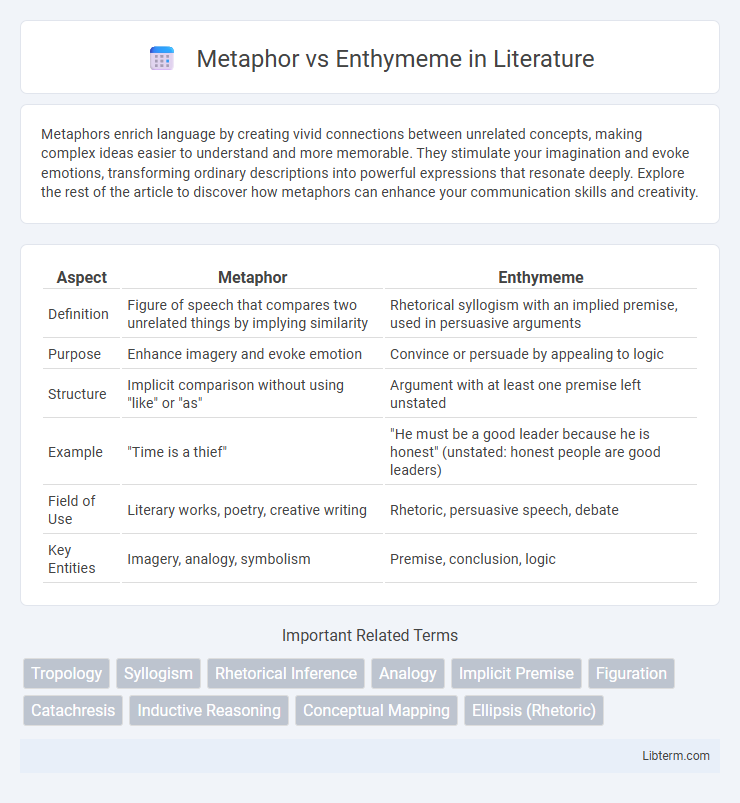Metaphors enrich language by creating vivid connections between unrelated concepts, making complex ideas easier to understand and more memorable. They stimulate your imagination and evoke emotions, transforming ordinary descriptions into powerful expressions that resonate deeply. Explore the rest of the article to discover how metaphors can enhance your communication skills and creativity.
Table of Comparison
| Aspect | Metaphor | Enthymeme |
|---|---|---|
| Definition | Figure of speech that compares two unrelated things by implying similarity | Rhetorical syllogism with an implied premise, used in persuasive arguments |
| Purpose | Enhance imagery and evoke emotion | Convince or persuade by appealing to logic |
| Structure | Implicit comparison without using "like" or "as" | Argument with at least one premise left unstated |
| Example | "Time is a thief" | "He must be a good leader because he is honest" (unstated: honest people are good leaders) |
| Field of Use | Literary works, poetry, creative writing | Rhetoric, persuasive speech, debate |
| Key Entities | Imagery, analogy, symbolism | Premise, conclusion, logic |
Defining Metaphor: Meaning and Usage
Metaphor is a figure of speech that describes an object or action by referring to something else with similar characteristics, facilitating a deeper understanding through symbolic comparison. It conveys meaning by implying equivalence rather than stating it explicitly, enriching language and thought. In contrast to enthymeme, which is a rhetorical syllogism with an implied premise, metaphor focuses on imaginative and figurative meaning rather than logical argumentation.
What is an Enthymeme? Core Concepts
An enthymeme is a rhetorical syllogism used in persuasive communication where one premise is implied rather than explicitly stated, allowing the audience to fill in the missing information. It relies on shared knowledge or common beliefs to create a logical connection between the stated and unstated premises, enhancing engagement and thought. Unlike metaphors, which draw imaginative comparisons, enthymemes function as condensed arguments facilitating effective persuasion through concise reasoning.
Historical Origins of Metaphor and Enthymeme
Metaphors trace back to ancient Greek philosophy, prominently discussed in Aristotle's "Poetics," where they are defined as rhetorical devices that convey meaning through implicit comparisons. Enthymemes, also rooted in Aristotle's "Rhetoric," originated as a form of syllogism used in persuasive arguments, characterized by the omission of one premise and relying on audience inference. These foundational texts established metaphor as a tool for figurative expression and enthymeme as a strategic argumentative structure in classical rhetoric.
Structural Differences: Metaphor vs Enthymeme
A metaphor structurally involves a direct comparison where one concept is understood in terms of another, typically comprising a tenor and a vehicle to convey meaning through analogy. An enthymeme, a truncated form of syllogism, structurally relies on an implied premise or conclusion, engaging the audience to fill in logical gaps within an argument. Unlike metaphors that emphasize figurative substitution, enthymemes prioritize argumentative function by leveraging shared assumptions and implicit reasoning.
Functions in Rhetoric: Persuasion Techniques
Metaphors function in rhetoric by creating vivid mental images that facilitate understanding and emotional connection, thereby enhancing persuasive impact through relatable and memorable comparisons. Enthymemes serve as implicit arguments that engage the audience's reasoning by leaving a premise unstated, prompting active participation and deeper cognitive processing to arrive at a conclusion. Both devices strengthen persuasion by appealing to different cognitive pathways: metaphors leverage imagination and emotion, while enthymemes stimulate logical inference.
Cognitive Effects: How Each Shapes Thought
Metaphors create cognitive effects by mapping familiar concepts onto unfamiliar ones, enhancing understanding through symbolism and analogical reasoning. Enthymemes engage the audience's inferential thinking by prompting them to fill in unstated premises, fostering critical analysis and active participation. Both shape thought differently: metaphors stimulate imaginative insight, while enthymemes develop logical reasoning skills.
Use Cases in Speech and Writing
Metaphors enhance vividness and emotional impact in speech and writing by creating imaginative comparisons that engage the audience's senses. Enthymemes, typically used in persuasive arguments, function by presenting an incomplete syllogism that prompts the audience to infer the unstated premise, strengthening logical appeal and involvement. In rhetoric, metaphors are preferred for storytelling and poetic expression, while enthymemes are strategically employed in debates and legal rhetoric for effective persuasion.
Examples: Metaphor vs Enthymeme in Action
A metaphor like "Time is a thief" implies time stealthily takes moments from life, invoking vivid imagery without explicit reasoning. In contrast, an enthymeme such as "He must be a good leader because his team trusts him" presents a premise and conclusion but leaves the underlying assumption ("Trusted leaders are good") unstated. These examples demonstrate a metaphor's role in figurative expression versus an enthymeme's function in condensed argumentative logic.
Strengths and Limitations Compared
Metaphors excel in promoting vivid imagery and emotional resonance, strengthening persuasive communication by appealing to audience intuition and creativity. Enthymemes, grounded in logical reasoning, enhance argumentative clarity and engagement through implied premises that invite audience participation. Limitations of metaphors include potential ambiguity and misinterpretation, while enthymemes risk flawed reasoning if crucial premises are unstated or misunderstood.
Choosing the Right Device: When to Use Each
Choosing the right rhetorical device depends on the communicative goal and audience engagement; metaphors evoke vivid imagery and emotional resonance by linking unrelated concepts through symbolic comparison, ideal for creative or persuasive contexts. Enthymemes, being truncated syllogisms that rely on shared assumptions, effectively prompt critical thinking and active participation by allowing audiences to fill in logical gaps, making them suitable for argumentative discourse. Selecting between metaphor and enthymeme hinges on whether the priority is emotional impact or logical persuasion within the communication framework.
Metaphor Infographic

 libterm.com
libterm.com